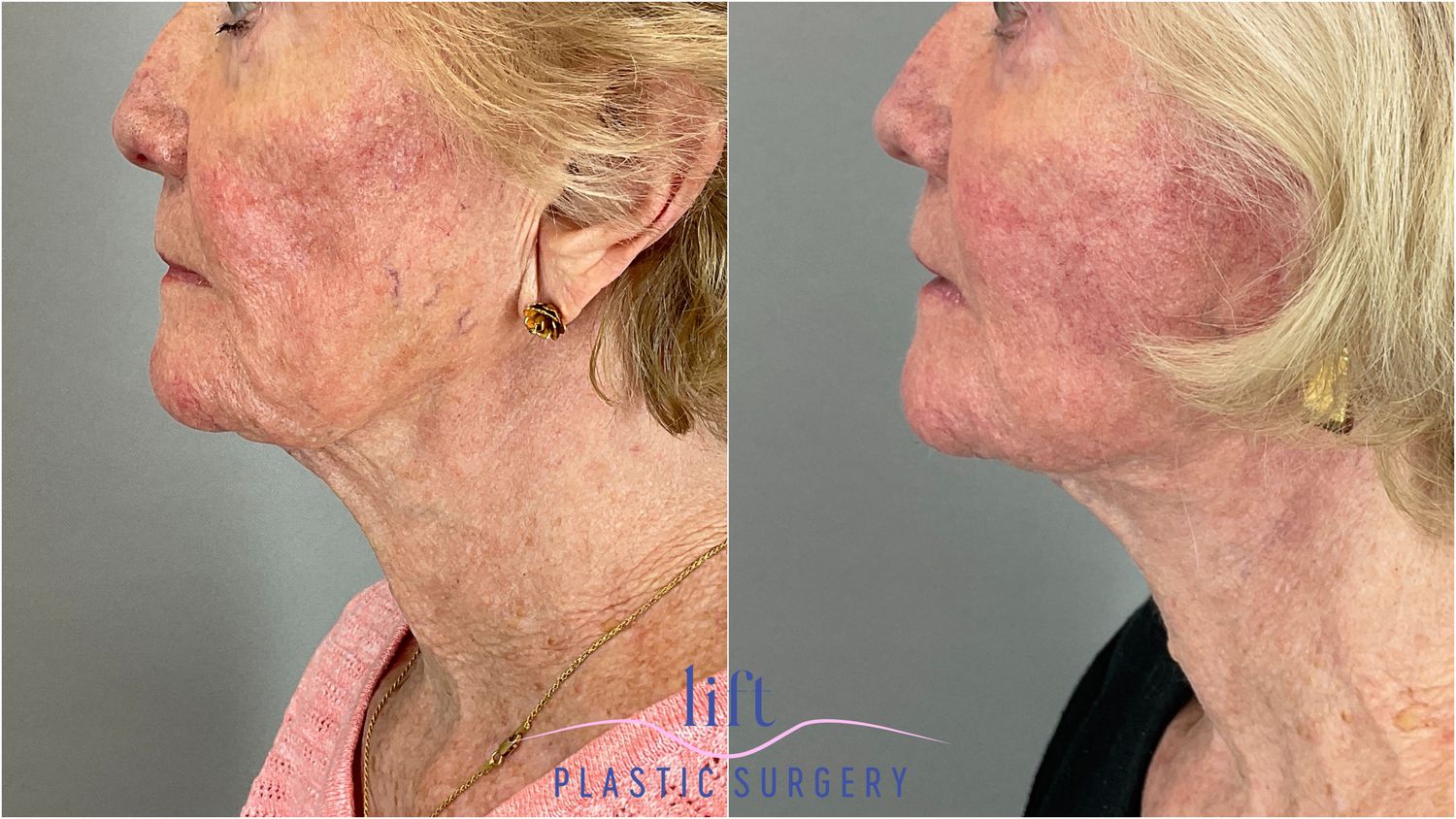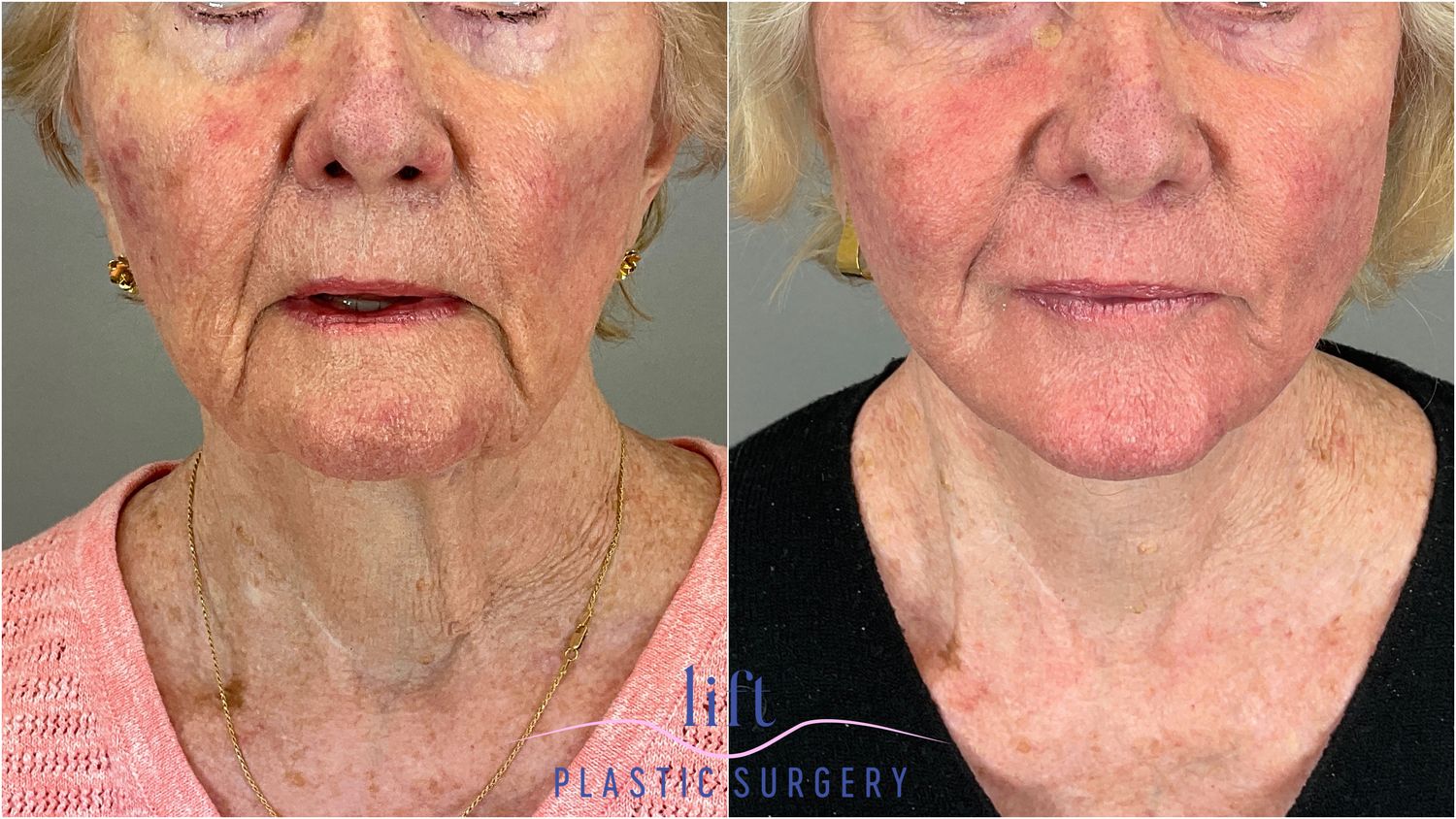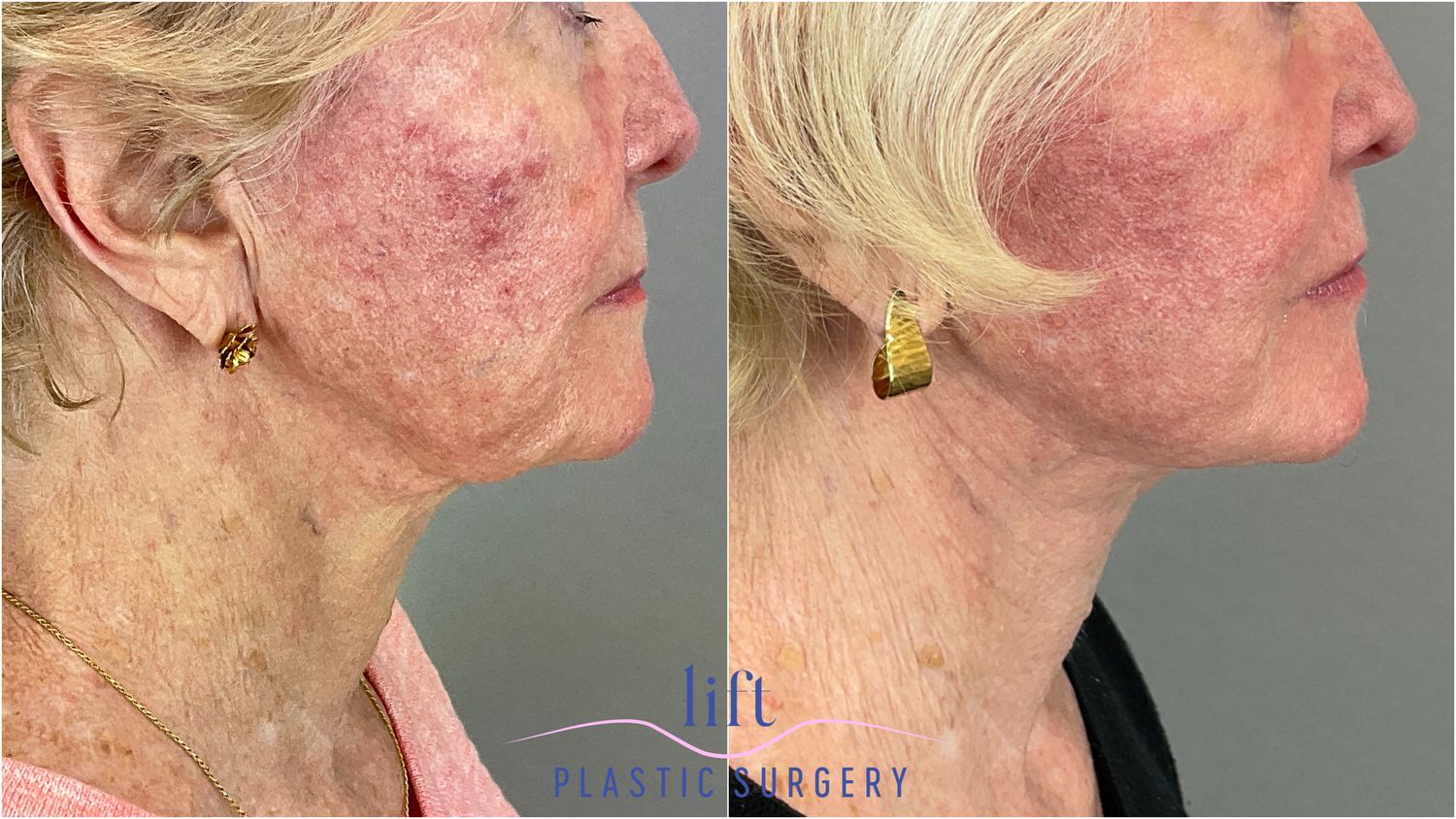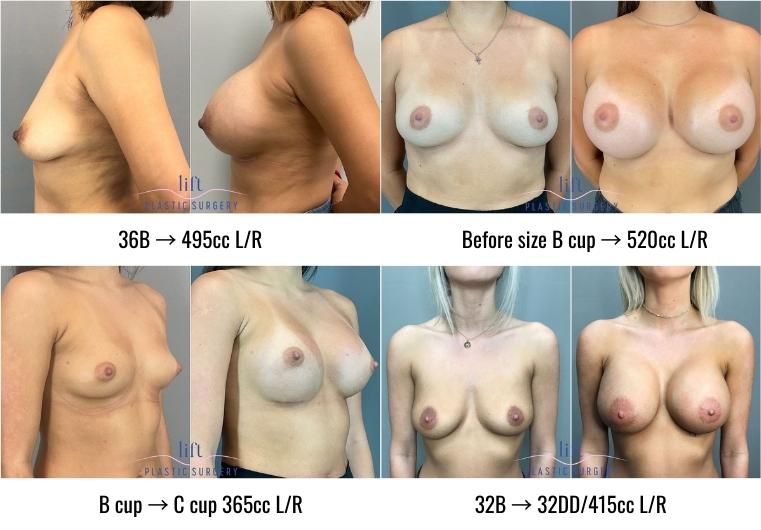Facelift Before & After
This is an 80-year-old female patient who lost some facial volume over the years and chose Lift Plastic Surgery because she wanted a more youthful look. To address her concerns she underwent a FaceLift with Fat Grafting to the Face and Lips.
FACELIFT (RHYTIDECTOMY) IN HOUSTON TX
As we age, the skin of the face becomes loose and wrinkled, and the muscles and fat begin to sag and slide down the face.
A facelift serves to reposition the fat and muscles of the face so that the contours are once again full and rejuvenated. The skin is then re-draped over this foundation and tightened to reduce wrinkles. Often a facelift is combined with fat grafting to help fill in some of the deeper furrows and hollow areas that cannot be addressed by the facelift alone.
WHAT HAPPENS DURING SURGERY?
The surgery involves making an incision that extends from the side burn, in front and around to the back of the ear and into the hairline.
The skin of both sides of the face is lifted carefully and then the muscles are tightened. The skin is then re-draped over the tightened muscles, extra skin is removed, and the incisions are closed with a combination of sutures and staples. A special head wrap dressing and drains are placed. The longevity of the procedure will vary for every patient, but will not be permanent. Aging and gravity will continue to occur, and some patients will desire a repeat facelift throughout their lifetime.
WHAT WILL MY RECOVERY BE LIKE?
The surgery requires you to stay overnight in the hospital for monitoring and strict blood pressure control. This minimizes potential bleeding complications. In the morning, the drains and dressing are removed, and you are discharged home, and may shower.
Expect that you will have facial bruising and swelling. This will be significantly improved after a week, but may take several weeks to completely resolve. You will also need to minimize exercise or vigorous activity for 4-6 weeks after surgery to allow for proper healing and to prevent bleeding and worsening of swelling. You should plan for activities accordingly. A compression garment worn for 4-6 weeks helps to decrease swelling and improve overall results. Sutures will be removed in the office after 5 days and staples after 10 days. Makeup should not be worn until incisions are healed.
WHAT ARE THE RISKS?
Although every precaution is taken during surgery, the nerves that control the muscles and movement of the face are at risk for injury during the procedure because they are so close to the skin.
If an injury does occur, it is usually not permanent. However, the nerves may take several months to recover. During this time, there may be weakness to the involved area of the face. The potential for nerve injury is greater in a repeat facelift because scarring makes the nerves harder to see, or may displace them into an unnatural position. The face is very vascular, so bleeding is also a risk after surgery, particularly if the blood pressure is not well controlled. This is very important in the first week after surgery, especially the first 24 hours. A collection of blood under the skin can cause potential wound healing, infection, or skin death. This is why we ask you to spend the first night after surgery in the hospital and to limit your activity level.
Houston Facelift Surgeons
As a natural part of the aging process, the facial muscles and fat begin to slide down the face. In addition, the skin becomes lax, resulting in the development of facial lines and wrinkles. Nonetheless, the Houston plastic surgeons at Lift Plastic Surgery address these signs of aging with a rhytidectomy, which is also referred to as a facelift. Plastic surgeons perform facelifts to rejuvenate the face. A rhytidectomy addresses skin folds and drooping skin on the cheeks and along the jawline. During a rhytidectomy, the plastic surgeon repositions the facial muscles and the fat to make the contours of the face appear fuller and more rejuvenated. However, in order to address some of the deeper furrows in the face, many of Lift Plastic Surgery’s patients decide to add fat grafting to their rhytidectomy. While performing a fat grafting procedure, the surgeon uses the patient’s own fat to fill in deep furrows. The surgeon also uses this fat to add volume to areas of the face that appear hollow (e.g., the temples). Fat grafting is necessary because the deep furrows and facial hollowing cannot be fully addressed with a rhytidectomy.
What Issues Can a Facelift in Houston Address?
With a rhytidectomy, Dr. Patel addresses numerous changes associated with the natural aging process.
These visible changes include:
- Jowls, which are created by excess skin along the jawline.
- Hollow-looking cheeks resulting from the loss of subcutaneous fat. Subcutaneous fat refers to the fat located just below the surface of the skin. Since the structure of the bone does not change as we age, this loss of fat causes the cheeks to sink in and look hollow.
- Sagging cheeks.
- The creases that run from the nose to mouth deepen.
- A facelift is not the procedure to address some issues.
These issues include:
- Sun damage.
- Superficial wrinkles.
- Variances in skin color.
- The creases around the upper lip and nose.
Who Should Consider Having a Facelift?
Although some people choose to have a rhytidectomy sooner, for the most part, a rhytidectomy is the ideal solution for addressing the signs of aging for individuals in their 40s, 50s or 60s.
Dermal fillers can address some facial issues that develop due to the natural aging process; nonetheless, if deep lines, wrinkles and sagging skin are present, the best way to address these issues is with a facelift. Some of Dr. Patel’s patients choose to have a platysmaplasty at the same time as their rhytidectomy. During a platysmaplasty, the plastic surgeon reduces the sagging and addresses fat deposits on the neck.
How Does a Facelift in Houston Combat the Signs of Aging?
A rhytidectomy targets the lower portion of the face, which includes the mouth, jawline and cheeks. During a Houston rhytidectomy, Dr. Patel addresses the signs of aging by pulling back the skin on each side of the patient’s face and altering the tissues beneath the skin. As skilled plastic surgeons, they can improve the contour of the skin. In addition, the surgeon removes the loose facial skin that is causing the wrinkles and sagging skin. Following a rhytidectomy, patients have firmer skin, which contributes to their more youthful appearance.
The First Appointment for a Facelift in Houston: What to Expect
Once an individual decides to learn more about having a rhytidectomy, he or she needs to call to schedule an appointment for an initial consultation.
During this first appointment:
Unless the patient has already filled out his or her registration information online, the first thing the patient does is fill out his or her registration paperwork. The information that patients need to complete this paperwork includes their medical history, current dietary supplements, herbal remedies, over-the-counter and prescription medications.
Recreational drug use and alcohol consumption:
Patients must also inform their surgeon about any participation in recreational drug use and alcohol consumption practices. This information is vital to ensure the patient’s safety during surgery. Since alcohol increases inflammation, patients must avoid drinking alcohol for at least six weeks before and six weeks after the facelift.
Avoid using products that contain nicotine:
In addition, patients who smoke or use products that contain nicotine need to let the surgeon know. Nicotine causes vasoconstriction, which means that the nicotine causes the walls inside the veins and arteries to contract. These contractions negatively affect the healing process, increasing the likelihood of a complication (e.g., an infection, slow wound healing, tissue death). Dr. Patel requests that their patients discontinue using these products for at least six weeks before and six weeks after their facelift in Houston.
Medical History
Patients need to provide information about current medical conditions and previous medical procedures. The surgeon wants to know about any surgical procedures the patient has had, including plastic surgery. If there was an issue that arose during a procedure, the surgeon needs to know. For example, some patients experience nausea after having general anesthesia. Informing the surgeon ahead of time allows this issue to be addressed with medication to prevent this side effect. If a patient experienced a complication during any of his or her surgical procedures, the plastic surgeon needs to know.
Evaluating the Patient’s Health Status
To get an idea of the patient’s overall health status, Dr. Shitel Patel may request recent medical records from the patient’s general practitioner or ask the patient to have a physical prior to his or her facelift procedure. This physical may include blood work and an EKG.
Medications, Daily Supplements and Herbal Remedies
Since a patient receives medications during a facelift in Houston, the plastic surgeon needs to know about his or her current medications, daily supplements and herbal remedies. For the sake of accuracy, many of Lift Plastic Surgery’s patients create themselves a list before the day of their initial consultation in Houston. This list should include the name of the medication/supplement/herb, as well as the reason the patient takes the product (e.g., Nasonex for the treatment of seasonal allergies). In addition, the surgeon wants to know how often the patient takes the product and the dosage amount. During this time, patients need to let their surgeon know if they have an allergy to any medications or latex.
Facial Examination
After evaluating the patient’s health, the plastic surgeon examines the face and neck. This examination includes determining facial fat distribution and bone structure, as well as noting his or her face shape and skin quality. If Dr. Patel believes the patient is a good candidate for a facelift, the surgeon may take pictures of the patient’s face. The surgeon takes these photos from different angles. The surgeon refers to these photos while creating the patient’s personalized surgical procedure plan for a rhytidectomy.
Patient Expectations
Patients need to inform their surgeon what they would like to accomplish with a rhytidectomy. Once the surgeon understands the patient’s expectations, he helps the patient understand what a rhytidectomy can and cannot accomplish. If another procedure can address the issues bothering the patient, Dr. Patel may recommend this other procedure in and of itself or as an add-on to the patient’s facelift. Ultimately, it is the patient’s decision which procedures, if any, are performed. Issues that a rhytidectomy does not address include facial asymmetry and fine lines.
Preparing for a Rhytidectomy in Houston
Since most patients rest for about two weeks, many find that their pre-surgical preparation is extremely beneficial following their facelift.
Pre-surgical preparation:
- Create meals that can easily be heated in the microwave or purchase pre-made meals.
- Ask someone to care for their pets, ideally taking larger dogs to another location during the first couple of weeks following surgery.
- Prescription medications should be picked up ahead of time.
- Choose a space in the home that is generally quiet.
- Be sure the space is comfortable.
Follow all the pre- and post-procedure instructions provided by Dr. Patel. By following the plastic surgeon’s instructions and addressing these issues ahead of time, the patient’s recovery should be uneventful.
At least two weeks before and after a facelift in Houston, patients should discontinue taking any medication, herbal remedy or dietary supplement that is known to increase the potential for excess bleeding (e.g., aspirin, NSAIDs, vitamin E). Patients who are taking a prescription blood thinner (e.g., Coumadin ®) need to speak with the physician prescribing them this medication about discontinuing or decreasing the dose of it for two weeks before and two weeks after their rhytidectomy.
On the day of their rhytidectomy:
- Patients may be asked to wash their face and their hair using a germicidal soap.
- Discontinue eating and drinking for eight to 10 hours before surgery. Patients who take medications during the time of fasting need to discuss their options with Dr. Patel.
- Patients need to ask someone to serve as a caregiver during the first two weeks following their rhytidectomy.
Find a Chauffeur and a Caregiver
Patients are not permitted to drive for at least 24 hours after receiving general or twilight anesthesia. Although patients remain in the hospital overnight, they still need to find a licensed driver to take them home from the hospital the following day.
Anesthesia Options for a Facelift in Houston
Patients may receive local anesthesia and sedation, which is frequently referred to as twilight anesthesia or general anesthesia. With twilight anesthesia, the patient is asleep, but can be awoken easily following the rhytidectomy. Patients who receive general anesthesia are in a deeper sleep, so they take longer to wake up. The surgeon determines which anesthesia will serve a patient better.
A Facelift in Houston: The Procedure
A rhytidectomy takes anywhere from two to four hours; however, if patients are having multiple cosmetic procedures during the same surgical session, they should expect their session to last longer.
- After the patient receives anesthesia and falls asleep, the surgeon creates an incision that starts in the hairline near the temple, continuing around the front of the ear, ending in the lower scalp. The surgeon creates this incision on each side of the face.
- Following the creation of the incision, Dr. Patel carefully lifts the skin.
- Now, Dr. Patel redistributes, removes or sculpts the facial fat.
- He gently lifts the facial muscles and repositions the tissues on each side of the patient’s face.
- The plastic surgeon redistributes, removes or sculpts the facial fat.
- The surgeon re-drapes the skin over the newly tightened muscles.
- Before using a combination of staples and sutures to close the incision, he removes the extra skin.
- The surgeon places a tube, which is attached to a small reservoir, behind each ear. These tubes allow any excess fluid and blood to drain off. Allowing fluid to drain into a small reservoir limits the amount of inflammation and bruising the patient experiences.
- Using a special type of dressing, the surgeon wraps the patient’s head. This head wrap runs around the side of the face from the top of the head to the chin.
When the amount of fluid that drains into the reservoir is below 30 to 40 mL within a 24-hour timeframe, the surgeon removes the drains.
Since the face continues to age, the results of a rhytidectomy usually last about 10 years. Once the signs of aging become apparent, patients can return to Lift Plastic Surgery to have another facelift.
Procedures and Treatments That Can Be Performed at the Same Time as a Rhytidectomy
If the patient desires, he or she can add on additional treatments and procedures.
Some of these cosmetic procedures include:
- Facial implants.
- A neck lift.
- Reducing the visibility of a patient’s wrinkles using dermal fillers or autologous fat.
- Resurfacing the face to improve tone and texture of the facial skin.
Will There Be Visible Scarring Following a Rhytidectomy in Houston?
Although there will be scarring, the surgeon camouflages the incisions by placing them within the creases of the patient’s ear and hairline. Placing the incisions in these locations ensures that they remain well hidden.
Recovering from a Facelift in Houston
For the first few days following a rhytidectomy, patients should expect to have inflammation and redness in their face.
Some patients state that they experience a feeling of tightness in their face.
Slight discomfort in the face is likely.
The initial recovery period lasts from 10 to 14 days. At this stage of the recovery process, patients can usually return to work.
Full recovery from a facelift can take up to three months. Once the patient reaches this stage, he or she should no longer experience tightness.
Heading Home the Day After Surgery
The next morning, as long as the amount of fluid and blood draining has remained below 30 to 40 mL, the surgeon removes the dressing as well as the drains.
Dr. Patel discharges the patient to his or her driver.
Upon returning home, the patient may shower.
To minimize the potential of unnecessary inflammation and to prevent bleeding, patients must avoid or greatly limit their participation in vigorous activities and exercise for at least four weeks after surgery, possibly six. Patients who are interested in exercising during this time need to speak with their surgeon.
Patients wear a compression garment around their face for at least four weeks, possibly six. This garment helps reduce the inflammation a patient experiences and improves his or her final result.
The surgeon removes the staples within 5 to 10 days of the patient’s facelift.
Patients must avoid wearing makeup until the incisions have healed.
Potential Complications that Require a Call to the Surgeon
These signs include:
- Pain in the chest.
- Shortness of breath.
- An irregular heartbeat.
- Severe neck or facial pain within the first 24 hours of surgery.
Following their rhytidectomy, patients must remain in the hospital overnight. During this overnight stay, the patient’s blood pressure is monitored. Controlling his or her blood pressure greatly reduces the likelihood of a bleeding complication.
Recovery tips for the first few days following surgery:
- Follow the doctor’s instructions for the frequency of pain medication. For example, if the surgeon’s order states that the patient should take his or her pain medication every six hours, skipping or delaying a dose could result in the patient experiencing unnecessary pain.
- Patients should keep their head elevated, even while resting.
- Cool packs can help reduce inflammation and ease pain.
Potential Complications and Risks
The plastic surgeons at Lift Plastic Surgery in Houston take great care in following every precaution before, after and during surgery. Choosing an experienced plastic surgeon is vital to attaining optimal results because during a rhytidectomy, the surgeon must create incisions close to the nerves and muscles that are responsible for controlling facial movements.
If a patient is having his or her second rhytidectomy, the potential for a patient to experience nerve injury increases because the scarring makes it harder to see the nerves. In addition, the scarring could cause the nerves to move to another area.
Since the face is vascular, excessive bleeding is a risk following a facelift in Houston. This complication is particularly of concern for those who have hypertension.
If blood collects under the skin, this could affect the body’s ability to heal itself. In addition, an infection may develop, leading to skin death.
These are the reasons the surgeons at Lift Plastic Surgery keep the patient overnight and limit his or her activity level during recovery.
Potential risks associated with a facelift include:
- Visible scars that are raised and red. The surgeon may address this visible scarring with injections of corticosteroids or some other treatment option that is available.
- Hair loss, which could be temporary or permanent.
- A hematoma, which typically develops within 24 hours of surgery. A hematoma is a collection of fluid beneath the skin that causes inflammation and pressure. Dr. Patel promptly addresses hematomas to ensure that there is no damage to the skin and surrounding tissues.
- A nerve injury that causes temporary or permanent paralysis. A temporary loss of sensation can last from several months to a year. When a nerve injury only affects a single muscle in the face, the patient’s face may droop, resulting in facial asymmetry.
- Skin loss, which occurs if there is an interruption in the blood supply to the face.
- An adverse reaction to medications used during the surgery.
How Patients Can Reduce Their Risk of Experiencing a Complication after a Facelift
Choosing an experienced plastic surgeon to perform their rhytidectomy in Houston can help reduce their likelihood of experiencing a preventable complication.
During the first three weeks of recovery, patients can reduce their risk of experiencing a complication by:
- Closely follow the instructions the surgeon provides in relation to wound care.
- Once the scabs develop on the wound, do not pick at them. By opening the wound, it becomes susceptible to bacteria, increasing the likelihood of developing an infection. In addition, this picking could cause the resulting scars to become visible.
- Wear tops that do not have to be pulled over the head.
- Follow the surgeon’s instructions related to using soaps and shampoos. Make sure to ask which of these products are best to use during this initial recovery period.
- Avoid participating in aerobic activity and vigorous sports.
- Do not wear makeup.
- Keep the incisions out of UV light. If this recommendation is disregarded, the patient’s scars will probably be visible because they will darken due to the UV light.
Sunscreen cannot be used during this initial three-week period, nonetheless, after the first three weeks have passed, patients can use a sunscreen that is SPF 30 or higher.
For the first six weeks of the recovery process, do not:
- Use products that contain nicotine.
- Drink alcoholic beverages.
- Participate in recreational drug use.
- Perm, bleach or color the hair for at least six weeks.
Individuals who are having a facelift to look more rejuvenated at an upcoming event need to have their rhytidectomy at least three months before the event.
Common experiences following a rhytidectomy include:
- Inflammation.
- Bruising.
- Pain that is mild to moderate.
- Numbness.
- Drainage from the incision sites.
Post-Op Appointments
Dr. Patel wants to see the patient several times during the two months following a facelift.
A typical post-op appointment schedule is:
- The day after surgery. During this appointment, the surgeon will most likely remove the drains and apply an antibiotic ointment to the incisions. In addition, the patient receives new bandages.
- Two or three days post-op, the patient may be able to start wearing an elasticized facial sling, which is usually more comfortable than the original head dressing.
- About seven days after the surgery, the surgeon removes the stitches and then assesses the wound.
- The surgeon may request that the patient return for monitoring purposes and so the surgeon can view the final result.
Facelift Results
A rhytidectomy can provide the patient with a more youthful-looking face. Results usually last about 10 years.
Finding Out How Much a Rhytidectomy in Houston Costs
Individuals who are considering a facelift need to contact Lift Plastic Surgery and schedule themselves an initial consultation. During the consultation, the surgeon can give the patient an idea as to what his or her rhytidectomy may cost.
If you are in the Houston area, and you would like to learn more about a facelift, contact Lift Plastic Surgery today. Dr. Shitel Patel helps people rejuvenate their appearance using an array of surgical and non-surgical procedures.
Contact Houston / Webster, Texas Plastic Surgeon Shitel D. Patel, MD at Lift Plastic Surgery.
For more information on cosmetic procedures and treatments provided please schedule a consultation.
Serving patients in Houston Texas, Webster, League City, Pearland, Galveston, Kemah, Seabrook and all other surrounding Greater Houston, Texas communities and more.





